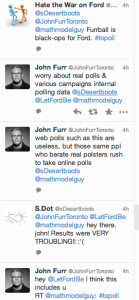Toronto voters are confused. Discussions concerning the veracity of landlines to cell phones in polling circles and questions about just what these numbers mean permeate the media. Strategic voting is being seriously discussed and individuals are literally twisting their logic into a variety of fascinating shapes to simultaneously make their vote count and stomach policies that do not resonate with their internal values.
The initial question I had this morning was to try to explain how polling firms can unintentionally influence voters through their proprietary weighting schemes. From a mathematical standpoint, the level of complexity inherited by the voting process when strategic voting is modelled destabilizes the voting process. One ends up with a situation there “the tail of polling” begins to “wag the dog of the voter”. With this analogy, it is safe to infer that the polling infrastructure itself is in crisis.
What I tried to do this morning was to get a sense of how people felt about the policies that they were seeing developed by each of the four front-running candidates for mayor. They were asked to consider the following:
Ignoring all polls and simply based on the content of the candidates platform, who would you vote for in Toronto’s mayoral election?
Candidates were listed in alphabetical order by last name and I asked everyone I could to spread the word and express what they thought. It was posted to Facebook, Reddit and Twitter. With each posting, it was asked to be reposted, shared, and re-tweeted. The poll remained open from 11:15-1:15 and only used a simple safeguard based on IP address to prevent repeat voting.
What was exceedingly interesting to me was not the final result, but how the final voting distribution developed, and I learned that it is not analysis or quantification of results that is driving voters. It is sociology.
In the first fifteen minutes of the vote Chow and Soknacki garnered nearly all of the votes, but with only about 30 votes shared between them (Chow 6, Ford 3, Tory 2, Soknacki 21, Undecided 1), this was not statistically significant (roughly accurate to 1 in 5). It took about 30 minutes for the internet to realize that this poll was out there and people started to take notice. I was struck by how the distribution, up to this point, was amazingly stable with Soknacki’s platform the clear leader being followed distantly by a smoothly decreasing distribution of Chow then Ford then Tory and finally Undecided. This is when things started to get interesting.
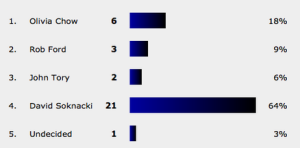

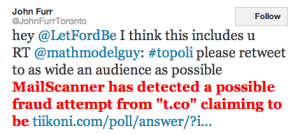
The next tweet from this person was a link to the poll to a vocal and active pro-Ford group and at this very point, Ford’s numbers began to rise. Let me repeat this for emphasis.
An anti-Ford leader joined forces with a pro-Ford organization!
The fear of one person being in the lead, regardless of the fact that the numbers were inconsequential in my poll, was all that it took for this individual to ensure the retention of a mayor and in this action, inadvertently unravelling their months of hard work to prevent exactly this situation!
This single reactionary tweet caused a cascade in the polling where fear and a sense of disenfranchisement replaced a reflective comparison of the various platforms. Putting this into context, the candidates that were not included, are not included in mainstream polling, and most debates and what I had done was not dissimilar to recent polling efforts.
Rather than have another candidate that this person does not hold in high esteem lead a pointless poll, this person was willing to turn to a candidate who according to their actions is vastly different than their political position. That reaction, that path to a strategic voting plan, changed the voting outcomes of the poll.
The rest of the voting distribution remained invariant while Ford’s numbers started to rise. Concurrently, word of the poll started to get some traction on the twitter stream I was monitoring and as the tone became more divisive, Ford slowly closed on the substantial lead that Soknacki had built up over the previous hour. By 12:45 pm (90 minutes elapsed) it was essentially a dead heat. This time coincided with a link to the poll being posted to a pro-Rob Ford site. Soon after this Ford overtook Soknacki and never looked back. At 12:57 pm the counts were Chow 36, Ford 106, Tory 23, Soknacki 81 and Undecided 8 and the final distribution at 1:15 pm is displayed below.
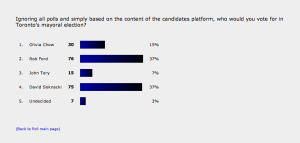
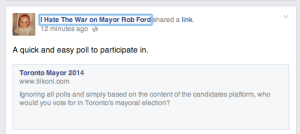
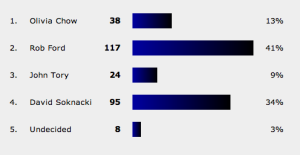
At the end of the day what my experiment has revealed, is that for democracy to truly work, we need to allow ourselves to be active participants in democracy. This poll was presented to voters via social media with no true description of its purpose. Once the link was posted, it automatically triggered a strategic voting response to counteract fear, or sense of loss.
Democracy is not about reaction to a fear. Democracy is not a reaction to the supposed outcome as promoted. What democracy is, is an opportunity for you to ask elected leaders to represent your principles, to represent your vision of the future. To simply vote in reaction to polls which are malleable to various interpretations, requires you to step away from your democratic voice.
There is a very important historical reference to this. Rousseau, the last of the social contract theorists, believed that a democracy, such as that in England in his time, led the English people to believe they were free. He disagreed and felt they were greatly mistaken and that they were only truly free during an election of the members of Parliament. Once officials were elected, the populace was effectively enslaved by their choice. The English people only made paltry use of their moral civil freedom through politics, enacting them only in the brief moments of elections, and Rousseau believed this squandering of liberty warranted their ultimate loss of it.
Rousseau is asking us to use our democratic freedom, not simply in the act of voting, but through the act of being civically engaged. The person whom you vote for is not simply an \(X\) you put on a ballot; they are the person with whom you will work for the next four years to build the city, the province, and the nation in which you live. That person must be someone you can work with, and someone that will represent your voice in those instances when you cannot actively participate yourself.
Perhaps Rousseau is right, that we have a citizenry who only evokes their voice in the general assembly during elections, and are then enslaved through a loss of moral civil freedoms. Perhaps with making such little use of our liberties, we have effectively lost them. Personally, I would like to believe that with a resurgence of activism, of protest, both physically and in the virtual realm, that the voice of our moral freedom is on the rise. Through civil action, and through bringing together a multitude of voices into the public sphere, we are finding our liberty and moral freedom as we find our voice.
In a June 29, 2013 article of the Globe and Mail, Naheed Nenshi, mayor of Calgary, summed this up succinctly with the following
We as citizens have the power to take people from devastation to hope.
P.S.
The story does not really end here for the poll this afternoon. It seems that in the wake of of the tipping point experienced in the polling exercise and in the afterglow of slaying imaginary dragons a conspiracy has taken root. As this is evolving by the minute, I leave it as an amusing homework—I’m a prof, I can’t help myself—to go check it out for yourself.
If I could just take one final moment of your attention. Reflect on my initial question in the poll. This is important, this will be on the test…
Ignoring all polls and simply based on the content of the candidates platform, who would you vote for in Toronto’s mayoral election?
Repeat it, repeat it to your kids, repeat it to your significant others, repeat it to yourself. When this is the question you ask yourself when you are staring at that blank voting sheet, and only then will you be practicing democracy. Think on that.
P.P.S
For more on the social and political analysis of what transpired this afternoon refer to the Philosopher of Write.
I have attempted here hide the underlying mathematics since let’s be honest, I’m in a minority for the joy I feel with respect to this. At any rate, there is a rich mathematical structure at play here that predicts that this poll would have ended up in a two-way race no matter how the participants behaved. If you would like to read more about this then consider the follow extra readings.
1) David P. Myatt (2001) Strategic Voting Incentives in a Three Party System
2) Mark Frey (2007) Duverger’s Law Without Strategic Voting
3) Ken Kawai and Yasutora Watanabe (2012) Inferring Strategic Voting
